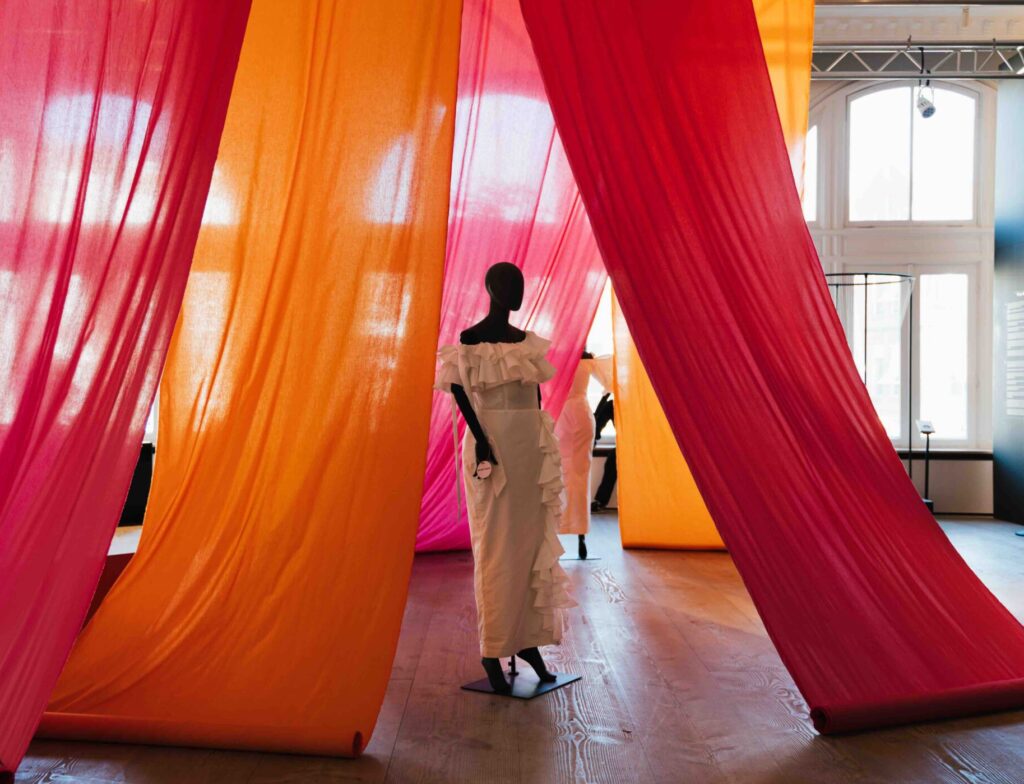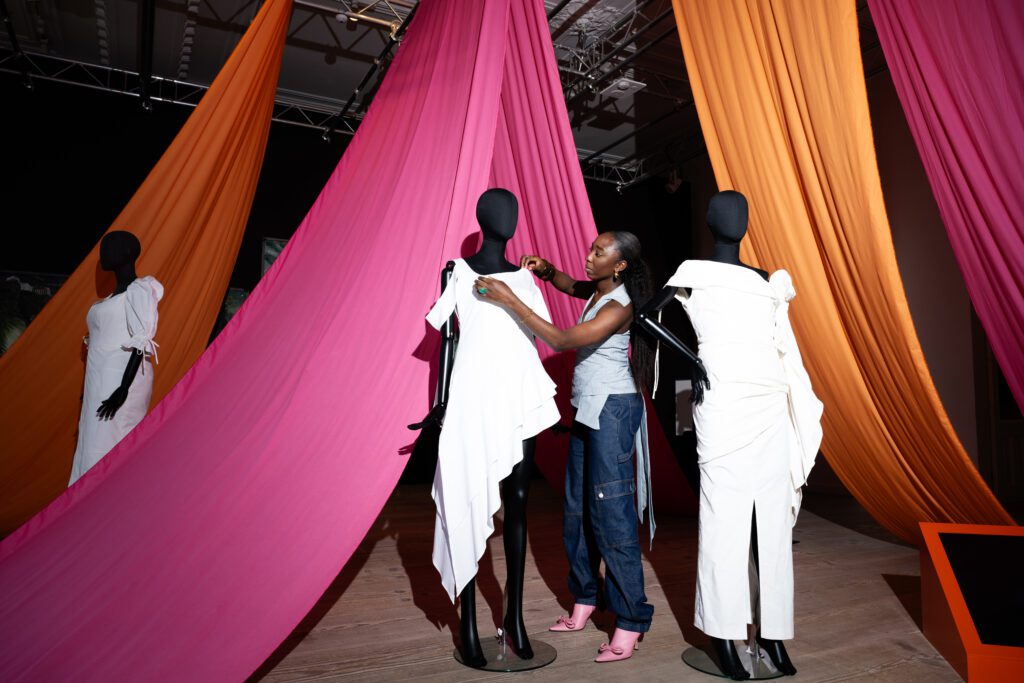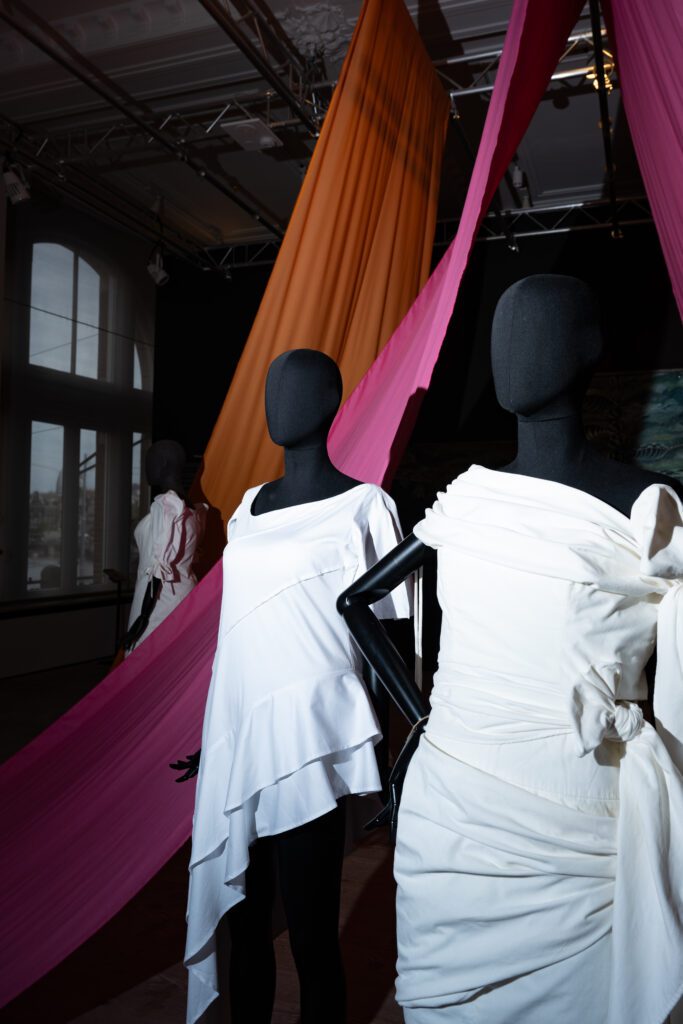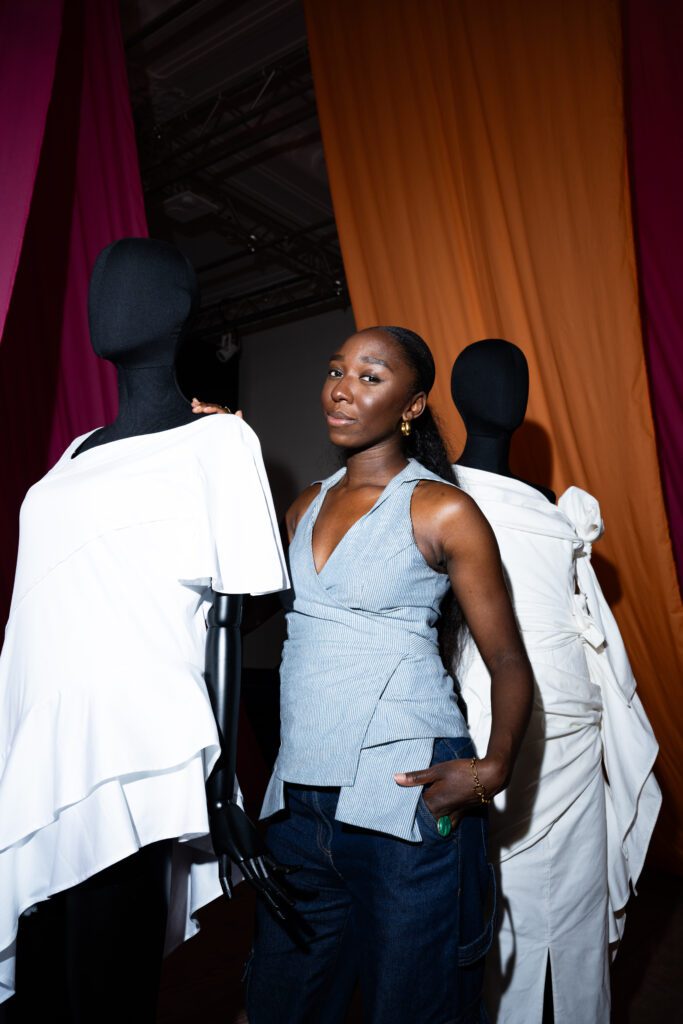Who are you and what do you love most about what you do?
I’m Nsimba Valene Lontanga. Nsimba is my African name and Valene, I would say, is my Western name. That’s just what it is. I love to tell stories, and I can do so by creating things and using fashion as a tool, I can do so by writing and by talking. It’s all about storytelling and inspiring people to think or move differently, make different choices or connect with other communities. Telling stories that make an impact in some way is what I love to do. I think, and maybe that’s an African way of thinking, at the end of the day we are all telling stories to live. I feel like that’s the core of us being here. We tell stories in order to live, to connect, to belong, you know? It’s so human, it’s so basic, and everyone can do it, and every story is unique. That’s why I love it.
Which role does sustainability play within your work and practice?
When I talk about sustainability, it always starts with the people I involve, how we can create sustainable relationships, and how we can make sure that everyone can live and sustain their life. I think sustainability for me has been about focusing on the people that are part of my practice. So really trying to create a sense of a community that tries to move forward together. The process of building my business is always about envisioning and creating these circles like an ecosystem, where everyone involved has an important role to play but also profits from what I do. So sustainability for me is also about togetherness, which is why my tailors are my collaborators and not just makers behind my products.
The exhibition at Fashion for Good is called Knowing Cotton Otherwise. You are part of the third chapter titled Flipping the Script. Can you tell us more about your contribution to this exhibition and what your process was like?
I got involved at the beginning of the exhibition, and the idea was more for me to have space to research and find out what type of story I wanted to tell. In the first part of the exhibition, we made a video where I spoke about my worlds of inspiration and what I hope to get out of this process. When connecting with the museum, I didn’t have a good idea of what I wanted to do. That was the first part where I just shared my vision of sustainability and fashion, but not the concrete story of what I wanted to do. When they said that the exhibition was going to be called Knowing Cotton Otherwise, I immediately felt that I needed to tell a story that somehow felt unheard. I also heard about the partnership I was going to get with Oritain, which was a decision that had already been made beforehand. Oritain is a company that uses this advanced technology to trace back where textiles come from. I got inspired by their traceability process and to see what traceability means for me. I got inspired to create designs that trace back the origins of styles that are part of our modern-day life. It resulted in looking at how African women, African aunties, to be specific because I’m Congolese, how Congolese women have always influenced styles and how those styles are part of fashion today but not always traced back to these women.
Your installation is named Elements of Poetry. What is your definition of poetry? And what are these elements you chose to highlight within this exhibition?
It was a very interesting and challenging process because I felt that telling an African story as someone who lives in the diaspora, I also need to involve the people who are owners of these narratives. I always work with tailors, who are tied to these stories, and I made sure that the items were made in Africa. I work in Ghana with a very close friend and tailor named Tetteh Kwashi Yawehson. I was doing my research, I did the sketches and then got in conversation with him to dream up these items. This was a process of mainly long video calls, which is a different way of designing. He was working in the atelier draping things on a model, using pins and cutting things for us to really work together on the silhouettes. I loved how I was, for instance, able to do fitting sessions in the African way, not having these sample size models coming in the atelier to try out the pieces and instead women that we knew from the neighbourhood where he lives. Women of all ages and all sizes came to visit to try on the pieces whenever they had time. We made an effort trying to create in an African way as much as possible in all the different layers of the process.
The title Elements of Poetry is inspired by the rhythms of Congolese Rumba, which is a genre that got popular after the Independence of Congo and is known for its poetic lyrics in Lingala. Lingala is a Bantu language that we speak there and represents resistance and the reclamation of the Congolese narrative. I used the title Elements of Poetry because Congolese Rumba is poetry. It has a lot of elements of poetry, from the words they use to the type of music and the sounds, it’s very poetic, and I’ve always seen my aunties dancing and expressing themselves on these poetic rhythms of Rumba. I saw a connection between how Rumba is a reclamation of Congolese narratives and the celebration of the origins of styles as a tribute to these aunties and also reclaiming these African styles. That’s the connection with the title and how it comes back in the installation. Every silhouette has elements of Rumba as well. Each piece has a poetic essence through elements such as wrapping, the ruffles, and the billowing sleeves. It is poetic, and the aunties that wear it move in it in such a poetic way, so it just makes sense for me to use this. It’s a celebration, but it also has a political message because of the music and what that music means in the Congolese landscape.
What do you hope people take away after seeing your work in the museum?
The exhibition is mainly about sustainability and I feel like sustainability is nowadays seen as a trendy thing. I recently saw this interview with Celine Semaan. She’s the founder of Slow Factory, an organisation that addresses climate change issues through education and different things. She said something that I hope people also take away from my work, which is about our ancestors, and with our ancestors, she referred to people from the Global South. She said that many people from the Global South have always been living sustainable lives before these terms became buzzwords. That’s what I hope for people to see and realise, that this subject, we are all now trying to make some marketing tool, is part of culture. I don’t like how African fashion styles are othered as something traditional most of the time, while so many of these styles have been influencing modern-day styles. It’s the same as African art always being put in a context outside of contemporary art, while artists like Picasso derived so much inspiration from our ancestors’ local communities. For me, it’s about showcasing my work and an African story in a way that doesn’t have to do anything with a traditional context. African styles, no matter from which year, are relevant for the time that we are living in now because they have so much influence on how we are moving now. That’s what I hope people see and realise.
Why is a community-driven mindset that strives for collectivity important?
Togetherness, in general, is such an integral part of the culture that raised me. For example, look at all the African proverbs from “it takes a village to raise a child,” to “if you want to go fast go alone, if you want to go far go together.” At the end of the day, all we do in life but also the things that we do as creatives are about a sense of belonging. My work, for me, is a way of creating a space that feels like home for those who don’t feel like they belong in other fashion narratives. Community and collectivity are the essence. If your work and that’s my personal opinion, doesn’t inspire community or collectivity, then what are you doing it for? We all want to belong, and we all want to connect. That’s why we are here, so it’s very important to me.




